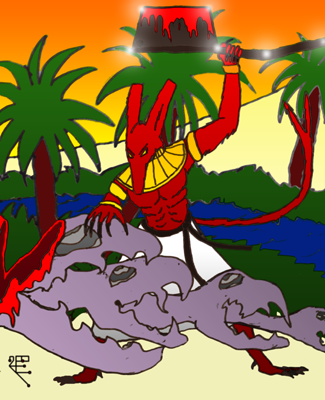Tackling the anti-Setian trope that Set is the “God of evil” or “Egyptian devil.”

In popular culture, Set is usually cast as the Egyptian “God of evil,” a kind of “proto-Satan.” You see it in the Conan stories, Doctor Who, the Marvel Universe, Vampire: The Masquerade, and most recently in the 2017 Mummy reboot. But popular culture’s version of Set is not the Set who was actually worshiped in ancient Egypt. The Set I know is more of an antihero who does things that none of His fellow Gods really want to do, but which have to be done anyway. His job is to make sure there’s always some kind of forward movement happening throughout every level of existence. Sometimes this means making trouble for the other Gods (as when Set slays Osiris or challenges Horus), and sometimes it means saving them from horrific chaos monsters (as when Set saves Ra from Apep each night).

Apep is the true adversary in Egyptian mythology. The hieroglyphic for its name is a snake, its body looped in multiple coils, its flesh pierced with butcher knives. This thing is much more like Satan than Set is, though it’s actually far worse. Satan’s just an angel at the end of the day; Jesus or Allah is destined to kick his hiney at the end of time, and he can only do whatever his Maker allows him to do (which says something about his Maker). Apep is not a being created or controlled by any God, but something more like a black hole, a vapid non-entity that just wants to eat everything. And since it isn’t a created being to begin with, it can never be completely defeated or destroyed. It can be repelled or execrated in various ways, but it always comes back. Despite its ultimate immortality, Apep is not a God, but more of an “Ungod.” It was never worshiped in Egyptian religion, but was only worshiped against. Set plays a major role in preventing it from ending the world each night, and that’s what I love most about Him.
Apep tries to murder the world by swallowing Ra, the sun God. We might be tempted to ridicule the Egyptians for thinking a giant snake was floating around out there in outer space, trying to eat our sun; but this assumes the story is meant to be taken literally. It’s also a disturbing metaphor about sleep, in which Ra “dies” each night and travels through the Netherworld to be “reborn” at dawn. As we sail through the unconscious terrain of sleep, we can encounter all kinds of frightening phenomena in the form of nightmares. Apep is the stuff nightmares are made of, and Set is the stuff nightmares are afraid of. Therefore, the theme of Ra’s salvation by Set is more like the oldest known version of “If I should die before I wake.” It represents the hope that we will all wake up again after going to sleep, even when we enter the sleep of death.

One of my most important rituals is what’s called an execration spell. I create things to represent my deepest, darkest problems; I invoke Apep into those objects; then I invoke Set into myself and smash, slice, or burn the objects in His name. I actually become the Power that my nightmares are afraid of, and I do to them what they would do to me. This procedure doesn’t solve all of my problems; indeed, anyone who expects magic to solve all their problems is gravely mistaken. But it does help me cope with them more productively. Externalizing one’s inner demons and symbolically destroying them can be very therapeutic, and Set is an excellent facilitator for such magic. If Big Red is “Satanic” when it’s between Him and Osiris and/or Horus, then He’s really quite Christian when it’s between Him and Apep.

Left: Set smiting Apep. Right: The archangel Michael smiting Satan. See the resemblance?
